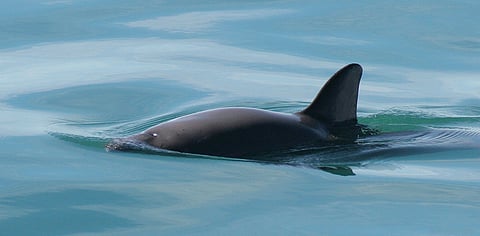

A report by the North American Environmental Commission has criticized Mexico for failing to protect the endangered vaquita porpoise, with only 10 remaining.
Illegal gillnet fishing for totoaba fish in the Gulf of California is a major threat.
Despite bans, enforcement is weak, prompting calls for the US to pressure Mexico under the USMCA.
A recent report by the North American Environmental Commission, a commission under the United States-Mexico-Canada Agreement (USMCA), has blamed Mexico for imperiling the vaquita porpoise, of which only 10 individuals remain in the world.
Mexico’s unwillingness to enforce its own wildlife protection and trade laws is driving the extinction of the vaquita, according to the Commission.
A major reason for the decline of the vaquita has been their being unintentionally caught in gilllnets which have been set to illegally catch totoaba fish. The totoaba is caught for its swim bladder, which is highly prized in East Asia.
The vaquita today is confined just to a small area in the Gulf of California or the Sea of Cortez, an inlet of the Pacific Ocean between the Baja California peninsula and mainland Mexico.
The report by the Commission detailed how illegal gillnet fishing and totoaba trafficking continue unabated in the porpoise’s Upper Gulf of California refuge, according to US non-profit Center for Biological Diversity.
According to the report, Mexico’s claims that it is taking enforcement actions are undermined or not supported by on-the-ground observations.
It cited an example. Despite Mexico’s ban on certain fishing gear since 2020, interviews and eyewitness accounts confirmed that “fishing activities continue at the similar levels and with the same [gear] as before the restrictions.”
“The Secretariat also found that fishermen “elude” fishing bans in the vaquita habitat by sending their illegal catch to processors in other regions. Mexico has failed to provide sufficient information, the report said, leaving central enforcement questions unanswered,” the statement by the Center said.
It added that under a Compliance Action Plan adopted by the Convention on International Trade in Endangered Species of Wild Fauna and Flora, Mexico was required to expand vessel inspections, install satellite monitoring units on vessels, and develop alternative gear to replace gillnets.
“Little progress has been made, however. As of June, Mexican officials had fitted only 10 of the 850 promised satellite trackers to monitor small boats fishing in the Upper Gulf.”
Experts quoted in the statement urged the United States to “use every tool under the USMCA to hold Mexico accountable and stop the illegal fishing that’s pushing the vaquita over the edge”.
Indeed, the Center’s statement concluded that now that the report is public, the US, through its Office of the US Trade Representative, can use the information to further press Mexico to combat illegal fishing in ongoing USMCA consultations.
“If those negotiations stall, the office can escalate to a dispute panel, which can authorize import penalties until Mexico fully enforces the gillnet ban in vaquita habitat,” it added.